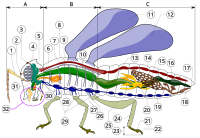
Photo from wikipedia
Many insects harbor obligate bacterial symbionts that can be vertically transmitted to offspring by female insects through eggs. Here, we report that leafhopper vitellogenin (Vg) recognizes and binds a surface… Click to show full abstract
Many insects harbor obligate bacterial symbionts that can be vertically transmitted to offspring by female insects through eggs. Here, we report that leafhopper vitellogenin (Vg) recognizes and binds a surface channel molecule (porin) on the envelope of obligate bacterial symbiont Nasuia, which potentially induces the opening of porin channels for Vg to access the cytoplasm of Nasuia. Thus, Vg can exploit bacterial symbionts as the independent carriers into the oocytes. Such Nasuia-carried Vg contents support efficient insect egg development. Thus, our findings indicate that insects have evolved strategies to exploit the symbionts for carrying additional Vgs to guarantee optimal insect reproduction. ABSTRACT Many insect species, such as aphids, leafhoppers, planthoppers, and whiteflies harbor obligate bacterial symbionts that can be transovarially transmitted to offspring through the oocytes of female insects. Whether obligate bacterial symbionts can carry important molecules/resources to the embryos to support egg development is still unknown. Here, we show that the vitellogenin (Vg) precursor of rice leafhopper Nephotettix cincticeps is biosynthesized by the fat body, secreted into the hemolymph and subsequently cleaved into the 35- and 178-kDa subunits, whereas only the 178-kDa subunit is taken up by the leading end of oocytes in a receptor-dependent manner or moves into the posterior pole of the terminal oocyte in association with obligate bacterial symbiont “Candidatus Nasuia deltocephalinicola” (hereafter Nasuia) in a receptor-independent manner. Furthermore, the 178-kDa Vg subunit can directly interact with a surface channel molecule (porin) on the envelope of Nasuia, allowing Vg to enter bacterial cytoplasm. Thus, Vg can hitchhike the ancient oocyte entry path of Nasuia, the common obligate symbiont of leafhoppers. Knocking down a Nasuia growth-related protein expression or treatment with porin antibody strongly prevents the ability of Nasuia to carry Vgs into oocytes and impair insect egg development. Nasuia-carried Vgs provide at least 20% of the total Vgs in the developing eggs. We anticipate that the bacterial symbiont-mediated Vg uptake into oocytes to support efficient egg development may be a common pattern shared by many insects. IMPORTANCE Many insects harbor obligate bacterial symbionts that can be vertically transmitted to offspring by female insects through eggs. Here, we report that leafhopper vitellogenin (Vg) recognizes and binds a surface channel molecule (porin) on the envelope of obligate bacterial symbiont Nasuia, which potentially induces the opening of porin channels for Vg to access the cytoplasm of Nasuia. Thus, Vg can exploit bacterial symbionts as the independent carriers into the oocytes. Such Nasuia-carried Vg contents support efficient insect egg development. Thus, our findings indicate that insects have evolved strategies to exploit the symbionts for carrying additional Vgs to guarantee optimal insect reproduction.
Journal Title: mBio
Year Published: 2020
Link to full text (if available)
Share on Social Media: Sign Up to like & get
recommendations!